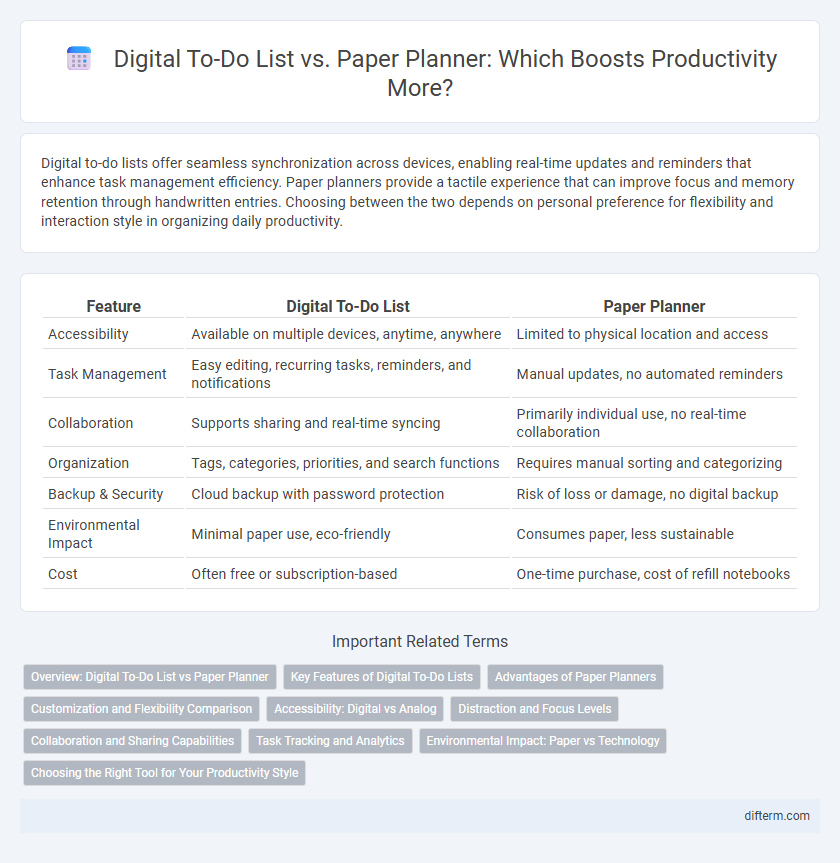Digital to-do lists offer seamless synchronization across devices, enabling real-time updates and reminders that enhance task management efficiency. Paper planners provide a tactile experience that can improve focus and memory retention through handwritten entries. Choosing between the two depends on personal preference for flexibility and interaction style in organizing daily productivity.
Table of Comparison
| Feature | Digital To-Do List | Paper Planner |
|---|---|---|
| Accessibility | Available on multiple devices, anytime, anywhere | Limited to physical location and access |
| Task Management | Easy editing, recurring tasks, reminders, and notifications | Manual updates, no automated reminders |
| Collaboration | Supports sharing and real-time syncing | Primarily individual use, no real-time collaboration |
| Organization | Tags, categories, priorities, and search functions | Requires manual sorting and categorizing |
| Backup & Security | Cloud backup with password protection | Risk of loss or damage, no digital backup |
| Environmental Impact | Minimal paper use, eco-friendly | Consumes paper, less sustainable |
| Cost | Often free or subscription-based | One-time purchase, cost of refill notebooks |
Overview: Digital To-Do List vs Paper Planner
Digital to-do lists offer real-time updates, cloud synchronization, and customizable notifications, enhancing task management efficiency across multiple devices. Paper planners provide tactile engagement, reducing screen time and supporting memory retention through manual note-taking. Both tools serve productivity, with digital solutions excelling in flexibility and automation, while paper planners aid focus and minimize digital distractions.
Key Features of Digital To-Do Lists
Digital to-do lists offer seamless synchronization across multiple devices, enabling real-time updates and access from anywhere, which enhances task management efficiency. They include features like automated reminders, priority tagging, and integration with calendars and email, streamlining workflow and reducing the risk of missed deadlines. Customizable templates and collaboration options further boost productivity by allowing shared task tracking and progress monitoring within teams.
Advantages of Paper Planners
Paper planners enhance productivity by providing a tactile and visual experience that improves memory retention and focus. Unlike digital to-do lists, paper planners reduce screen time, minimizing digital distractions and fostering a sense of mindfulness. Handwriting tasks in paper planners also boosts cognitive processing, leading to better organization and task completion.
Customization and Flexibility Comparison
Digital to-do lists offer unparalleled customization with features like tags, priority levels, recurring tasks, and integration with calendars and reminders, enabling dynamic task management. Paper planners provide tactile flexibility, allowing users to personalize layouts, doodles, and notes in a free-form style that fosters creativity but lacks automated adjustments. The choice hinges on whether users prioritize digital adaptability and automation or the physical interaction and freedom of analog organization.
Accessibility: Digital vs Analog
Digital to-do lists offer instant accessibility across multiple devices such as smartphones, tablets, and computers, enabling seamless task management anytime and anywhere. Paper planners provide tactile engagement and no dependence on battery life or internet connectivity, making them reliable in offline environments. Both methods cater to different accessibility needs, with digital tools favoring mobility and synchronization, while analog planners emphasize simplicity and physical interaction.
Distraction and Focus Levels
Digital to-do lists offer features like notifications and integrations that can increase distraction, while paper planners provide a tactile experience that enhances focus by minimizing screen-related interruptions. Studies show that writing tasks by hand in a paper planner improves memory retention and task prioritization, leading to higher productivity. Users often experience lower cognitive load and fewer digital distractions when relying on paper planners compared to digital alternatives.
Collaboration and Sharing Capabilities
Digital to-do lists excel in collaboration and sharing capabilities, allowing real-time updates, task assignments, and seamless synchronization across multiple devices and users. Paper planners lack instant sharing and require physical presence or manual duplication, limiting team coordination and dynamic task management. Effective productivity in collaborative environments thus favors digital tools for enhanced communication and streamlined workflow integration.
Task Tracking and Analytics
Digital to-do lists offer advanced task tracking features, including real-time updates, priority setting, and automated reminders that enhance productivity. integrated analytics provide detailed insights into task completion rates and time allocation, enabling data-driven adjustments to workflows. Paper planners lack such dynamic tracking and analytical capabilities, limiting users' ability to optimize task management based on performance metrics.
Environmental Impact: Paper vs Technology
Digital to-do lists significantly reduce paper waste by eliminating the need for physical pages, thereby conserving trees and lowering deforestation rates. Electronic devices used for digital planning require energy and create e-waste, but advancements in sustainable technology and device recycling mitigate these environmental impacts. Overall, choosing a digital to-do list supports environmental sustainability by minimizing resource consumption compared to the production and disposal associated with paper planners.
Choosing the Right Tool for Your Productivity Style
Choosing the right productivity tool hinges on understanding your work habits and preferences, as digital to-do lists offer real-time syncing, customizable reminders, and easy reordering for dynamic schedules. Paper planners provide tactile satisfaction and reduce digital distractions, promoting deeper focus and intentional planning for those who benefit from visual and physical engagement. Assessing your productivity style--whether you thrive with tech-driven flexibility or structured analog methods--ensures optimal task management and goal achievement.
Digital To-Do List vs Paper Planner Infographic

 difterm.com
difterm.com